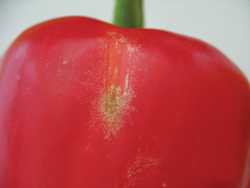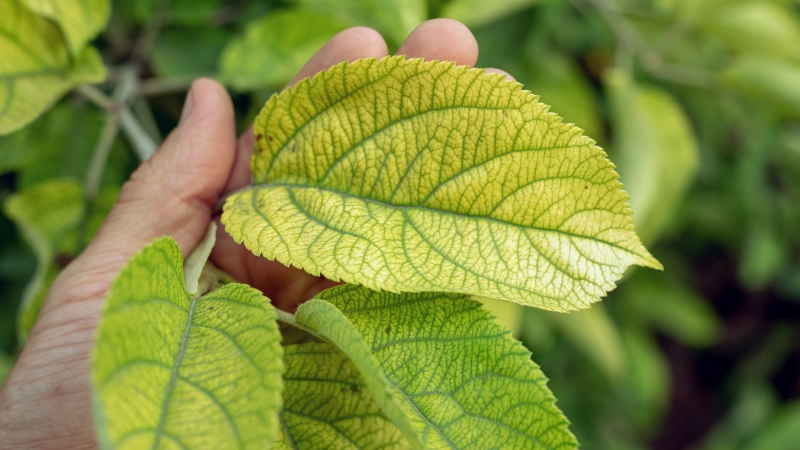Thwarting Thrips

Western flower thrips (Frankliniella occidentalis), a decades long problem in North Florida, has emerged as a serious pest of vegetables in South Florida. To deal with this problem, management programs developed in northern areas are being applied in the south. These involve a strict adherence to integrated pest management (IPM) tactics and conservation of beneficial insects.
Western flower thrips cause damage in two ways. The adults and immatures (larvae) feed on the epidermal cells of tomato and pepper fruits, causing damage known as flecking. Flecking also is a problem on green bean pods. The adults and larvae in very large numbers can damage strawberries. Adult egg-laying on tomato fruits and green bean pods causes dimples or halo spots. The adults can spread tomato spotted wilt virus, the most serious viral disease of tomatoes, peppers, and many other crops worldwide. The virus is a serious problem in North Florida. It has not been a major problem in South Florida, although some growers reported problems in May 2009 in the very late vegetables.
Taking Control
Management of tomato spotted wilt virus is complicated by a unique virus-vector relationship. Only the larvae can acquire or pick up the virus when feeding on an infected plant. The virus remains in thrips until adulthood. An infected adult can spread the virus to new plants. Insecticidal control of the adults is ineffective as the adults are able to transmit the virus quickly before death. Other tactics, such as ultraviolet-reflective mulches and disease-resistant crop cultivars, are needed.
Attempts to control insect pests with the calendar application of broad-spectrum insecticides only have exacerbated problems from western flower thrips. Broad-spectrum insecticides kill natural enemies and competitor species of non-damaging native thrips. The pyrethroid class of insecticides and some neonicotinoid insecticides enhance populations of western flower thrips.
The situation in South Florida is complicated by pockets of western flower thrips that have grown resistant to the spinosyn class of insecticides, which includes Success, SpinTor, Radiant, and Entrust (all Dow AgroSciences). This is the most effective class of chemistry against western flower thrips. The insecticide conserves natural populations of the minute pirate bug (Orius species), a voracious predator of western flower thrips. Dow AgroSciences, EPA, and the Florida Department of Agriculture took the proactive step of issuing a special local needs registration in Broward and parts of Palm Beach counties. This Section 24(c) label prohibits the use of spinosyn insecticides until July 2010 at which time usage will be re-evaluated.
Conservation of the natural populations of minute pirate bugs is very effective for control of western flower thrips in pepper, eggplant, and some other crops. One minute pirate bug predates on about 20 thrips per day. One predator per 180 thrips suppresses the thrips population and one predator per 50 thrips provides effective control. Several new insecticides provide some level of control of western flower thrips while, at the same time, conserving populations of minute pirate bugs. These include Requiem (Chenopodium ambrosioides near ambrosioides, AgraQuest), Beleaf (flonicamid, FMC Corp.), and several others in the process of being labeled. None of these newer products provide the effective level of efficacy as the spinosyn insecticides. However, they are still useful in an IPM program in preventing unacceptable crop damage.
Deterring Development
The best way to prevent the development of pest populations resistant to insecticides is by strict adherence to IPM. The new soft insecticides should relieve some of the resistance pressure against the spinosyn insecticides.
These new products should not be viewed as standalone controls and they should be incorporated into the IPM program. How to effectively use the new soft insecticides is still being investigated. This includes how to best rotate their use when multiple applications are needed. For example, Requiem is a biological insecticide derived from a plant extract. Under cooler conditions, it is more effective when the first application is followed by a second application about five to seven days later. During hot weather, control is observed within 48 hours.
University of Florida recommendations normally are made for individual pests. This is not effective when a grower employs a tactic for one pest that results in damage from another pest. Therefore, recommendations need to be vertically integrated across pests. Efforts are under way to develop pest management recommendations for western flower thrips that are vertically integrated (i.e., making recommendations that consider more than just one pest).
Pointers For Pepper And Eggplant Producers
Below are integrated pest management recommendations for western flower thrips in pepper and eggplant crops:
1. In scouting programs, distinguish between adult and larval thrips and identify adult thrips to species.
2. Economic thresholds are about six adult western flower thrips and palm thrips (Thrips palmi) per flower, and about two larval thrips per fruit.
3. Do not treat for adult eastern flower thrips (Frankliniella tritici) and Florida flower thrips (F. bispinosa) as they outcompete western flower thrips.
4. When peppers are flowering, use insecticides for thrips and other pests that conserve minute pirate bugs.
5. Never use insecticides that induce western flower thrips.
6. Use ultraviolet reflective mulches when forming beds.
7. Sunflower and other refugia provide a source for minute pirate bugs.
8. Vertically integrate management of western flower thrips with other pests, including pepper weevil and Lepidoptera pests.
9. Follow best management practices for fertility and irrigation management.
Tips For Tomato Growers*
Here are integrated pest management recommendations for western flower thrips in tomato crops:
1. In scouting programs, distinguish between adult and larval thrips.
2. Economic thresholds are about one western flower thrips adult per flower and about two larvae per fruit.
3. Alternate between efficacious insecticides.
4. Avoid using insecticides that induce western flower thrips populations.
5. Use ultraviolet reflective mulch when forming beds.
6. Vertically integrate management program for thrips with management of other pests including whiteflies.
Research is currently being conducted by several University of Florida scientists to develop similar recommendations for green beans, strawberries, and cucurbits.
*These recommendations are for South Florida where tomato spotted wilt virus has not been a significant problem to date. If there is a threat of tomato spotted wilt virus, additional tactics, such as resistant cultivars, need to be considered.









